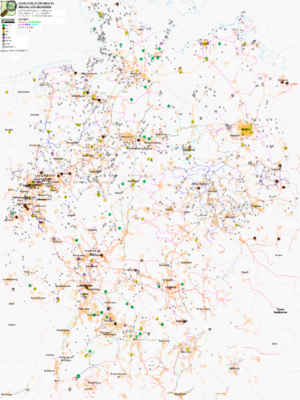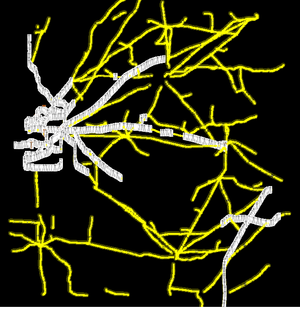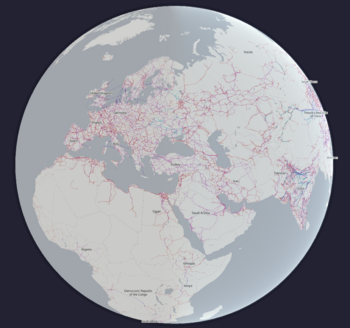Power networks
This is a project to map and document all power networks on the planet. This could be power lines, tower and substations. But also gas or oil lines.
To view guidelines regarding power generation see power generation page.
Mapping power networks is very useful for navigation, particularly for overhead lines.
If you are a power user, why not join the category:power user.
There is an IRC channel for discussing power networks and other infrastructure: irc.oftc.net #osm-infrastructure.
Electric power
Physical components
- Detailed article about power lines and power substations
- Proposal in progress: transmission and routing
- WikiProject Power networks/HVDC-Scheme
HVDC lines
An HVDC is a power line where for transmission DC instead of AC is used. As DC cannot be transformed like AC, AC has to be transformed to the desired voltage level, rectified and at the end of the line converted into AC again. As this requires expensive equipment the use of DC for power transmission is normally done only in the following case:
- interconnecting power grids of different frequencies or phase counts or which are not synchronized
- very long ( > 500 km) overhead lines
- very long ( > 50 km) cables
For the first case also plants are used, in which the conversion process into DC and back again into AC is done in the same plant. One calls these plants "back-to-back stations".
HVDC transmissions are either monopolar or bipolar. At a monopolar transmission one pole is grounded and sometimes even the ground is used as second conductor while the other has a high potential against ground. At bipolar lines one pole has positive potential to ground and the other negative. The ground or a conductor grounded at a single point, which is called metallic return, is used as common return of both poles.
The location of grounding points, which can be situated on land or in the sea, must be chosen very carefully, in order to prevent electrochemical corrosion. Therefore lines, the such called electrode lines, between the grounding point and the converter stations are required. The voltage level of these lines is not constant. It is the product of line current and ground resistance plus resistance of electrode line. In ideal systems it would be o volts, but in practice it may got values until 2 kV.
Electrode lines can be realized as overhead line or as underground cable. They can be installed on separate towers or use the towers carrying the high-voltage pole(s) of the HVDC transmission where they can, as they run to ground, also serve as ground conductor, whereby they have to be fixed on insulators equipped with lightning arrestors. In some cases (HVDC Pacific-Intertie, HVDC CU, HVDC Square Butte and HVDC Vancouver Island), the electrode line is installed on towers of an AC line. The installation of conductors of the high voltage poles of DC lines on AC towers was so far only realized in the switchyard of HVDC Volgograd-Donbass at Volgograd and at HVDC Kontiskan at Stenkullen, Sweden, whereby latter towers do not exist any more. However in China HVDC Hubei - Shanghai and HVDC Gezhouba - Shanghai, use in most part of its length the same towers.
As switches for HVDC are poorly available, so far HVDC is used nearly only for point-to-point transmissions and most realized systems consist of just 2 stations interconnected by the line. There are also a few multiterminal transmissions, but at no realized scheme more than 2 HVDC lines depart.
A good list of HVDC schemes can be found on list of HVDC projects. Most of these schemes are mapped at least in overhead sections already on OpenStreetMap. However no map of all existing HVDC schemes exist in the internet as there are no detailed maps of all schemes or groups of schemes.
Tags
The full list of power-related tags can be found on the power=* page.
You may find side information regarding socket=* or power_supply=*.
Proposals
- Substation refinement proposal.
- Power transmission refinement proposal.
- Power routing proposal.
Rendering
OpenInfraMap renders electricity, telecommunications, water, petroleum, and microwave communications infrastructure, also features a similar rendering of power lines in one of its overlays, Names of substations and their highest voltage, and power plants are also indicated.
Another visualization can be seen at Flosm.de.
MapCSS style
A mapCSS stylesheet is available for josm.
Oil and gas power
OpenInfraMap shows man_made=pipeline and substance=* on ways and areas.
Pipelines
- man_made=pipeline "Here is a pipeline"
- location=* underground|underwater|overground (optional)
- substance=value This can be <water|oil|gas|sewage|any substance> (optional)
- operator=name <name of the company operating the pipeline> (optional)
- Germany: Gasnetzkarte
| Abkürzung | Name der Pipeline | Marker von - Marker bis | osm data | Kommentar |
|---|---|---|---|---|
| NWO | Nord-West-Oelleitung | 19,34,36,37 | 30780560 |
|
| RRB | [Rohrleitung Rostock Böhlen] | 690-692 | 35103657 |
Quellen: [1] |
Substations
See pipeline=substation for any facility involving pipelines for inspection, compression or storage
Proposals
- Pipeline extension proposal.
Local projects

Local projects intend to document practices, knowledge and mapping guidelines relevant for a particular area in the world only. Feel free to create a dedicated one for your region if missing. Such page should only cover particular area (like countries or region) but not a given infrastructure or facility for sake of consistency.
- Power networks/Austria
- Power networks/Canada
- Power networks/China
- Power networks/Czech Republic
- Power networks/Denmark
- Power networks/France
- Power networks/Germany
- Power networks/Great Britain
- Power networks/Greece
- Power networks/Indonesia (translation in Indonesian)
- Power networks/Italy
- Power networks/Malaysia (translation in Malay)
- Power networks/Moldova
- Power networks/Netherlands
- Power networks/Norway
- Power networks/Philippines
- Power networks/Poland
- Power networks/South Africa
- Power networks/Switzerland
- Power networks/Tanzania
- Power networks/United States

